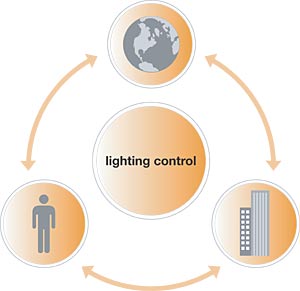The Essential Design Element for Any Office Space
Lighting Control Strategies
The key to achieving the best fit between an office building and its lighting control system is to first determine how the space should function and how it will be used, then identify which lighting control strategy delivers the functionality that supports the intent of the space. Each different lighting control strategy offers a unique blend of energy savings potential and controllability. Five strategies popularly employed in office buildings are: tuning, occupancy sensing, daylight harvesting, personal control, and preset control.
Tuning is a strategy that uniformly lowers the high-end light level available throughout a space or building. Instead of switching fluorescent lights between 100% on and off, tuning lowers the high-end light level to 90%, for example, so lights switch between 90% and off. This strategy provides energy savings to the building every time the lights are turned on, automatically reducing the amount of electricity used for lighting by 10%. Tuning is often employed in corridors, hallways, stairwells and other areas of the floor plate where lights are constantly on, but occupants do not require a high level of personalized control for task or comfort.
|
Occupancy sensing is a lighting control strategy that equips a building to turn lights off when rooms are empty. Occupancy sensing can create an average energy savings of between 25-40% and is typically employed in private offices and ancillary areas like copy rooms, kitchenettes, and bathrooms, where occupancy is sporadic.
Daylight harvesting balances the electric light and natural light in a space, automatically lowering electric light levels when daylight is present and increasing electric light levels in a space as daylight wanes. Daylight harvesting saves energy by using electric light as a complement to available daylight and protects the visual ergonomics of the space by ensuring that the appropriate amount of light is always present at the desktop. Daylight harvesting has been credited with reducing lighting energy consumption by almost 40% and can be incorporated into any office area that receives daylight exposure.
Personal control allows employees to select their own overhead light level and modify the light level throughout the day. Personal control gives employees the option to turn their overhead lights on, off, or to select a light level in between. This light control strategy has been credited with lighting energy savings of over 60% and is often applied in open office areas, private offices, and team environments.
Preset control provides a space with different pre-selected lighting scenarios. For example, a conference room wall station may be marked AV presentation, Meeting, Cleaning, and Off. Each of these scenarios is tied to a different light setting in the room. The AV presentation button lowers the light levels to accommodate the AV technology and makes it easier for people to see the screen. The meeting button engages overhead lights at a level that is on, but less intense than 100%, perhaps 75%. Cleaning provides 100% light so that staff can see dust and dirt. This lighting control strategy is most beneficial in areas that host many different employees for numerous types of tasks. Preset control makes it easier for the space to best fit the needs of the group, without being prohibitively difficult to use.
Incorporating the appropriate lighting control strategy in commercial buildings improves system efficiency and adds value to the space, but lighting control systems are able to further support office space design. Lighting control systems are available that provide tuning, occupancy sensing, daylight harvesting, personal control and preset control in a package that is easy to reconfigure, easy to maintain, easy to understand and use.
These features ensure that a system that was once the best fit for the office design will continue to fit organizational needs, even as those needs change.










